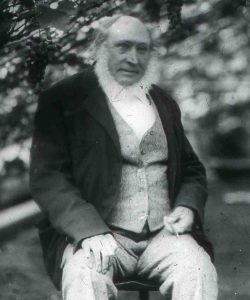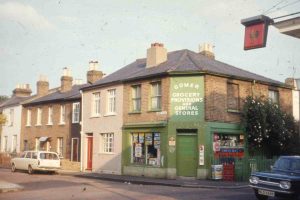R D Blackmore (1825-1900) – [Local History Notes: 19]

Richard Doddridge Blackmore was born on 7 June 1825 in Longworth, Berkshire, where his father, John Blackmore, was Curate-in-charge of the parish. Only a few months after his birth his mother died, the victim of an outbreak of typhus which occurred in the village. After this loss John Blackmore moved to his native West Country, first to Culmstock, Devon and then to Ashford in the same county. Richard, however, was taken by his aunt, Mary Frances Knight, and after her marriage to the Reverand Richard Gordon, moved with her to Elsfield rectory near Oxford. His father married again in 1831 whereupon Richard returned to live with him in Devon. Here he grew to know and love the countryside which was to figure so prominently in his most famous novel, Lorna Doone.
In 1837, Blackmore entered Blundell’s School in Tiverton. Here he excelled in classical studies and later won a scholarship to Oxford, where he took his degree in 1847. During a university vacation he made his first attempt at writing a novel. This was the beginning of The Maid of Sker, not, in fact, completed until many years later and eventually published in 1872.
Law
After leaving Oxford and spending some time as a private tutor, Blackmore decided on a career in law. He entered the Middle Temple in 1849 and was called to the Bar in 1852. Ill health, however, prevented him from continuing legal work as a full-time occupation and in 1854 he took the post of classics master at Wellesley House Grammar School, Hampton Road, Twickenham. In later years this became the Metropolitan and City of London Police Orphanage and then Fortescue House School. Soon after accepting this position, he moved from London to number 25 Lower Teddington Road, Hampton Wick, where he lived until he moved to his new home in Teddington.
1853 saw two of Blackmore’s works published anonymously. These were volumes of verses called Poems by Melanter and Epullia.
He was married on 8 November 1853 at Trinity Church, Holborn to Lucy Maguire. She was 26, a Roman Catholic and somewhat delicate and they never had any children. They were both fond of her sister Agnes’ four children and often had them to stay. As well as helping with their education, the Blackmores seem to have adopted Eva when she was 7.
In September 1875, Blackmore’s uncle, the Reverend H.H. Knight, Rector of Neath, died and left his nephew a sum of money which enabled him to realise a long-held ambition of possessing a house in the country encompassed by a large garden. Blackmore’s father encouraged him in the scheme and helped him to carry it into effect.
The land selected was a 16 acre plot at Teddington which Blackmore had seen and admired for some time. Here he built his new house, completed in 1860, in which he lived for the rest of his life. He called it ‘Gomer House’ after one of his favourite dogs, a Gordon Spaniel. In the extensive grounds he created an 11 acre market garden specialising in the cultivation of fruit. The grounds were surrounded by high walls which served to keep out thieves and to aid the ripening of tender fruit. His knowledge of horticulture was extensive, but because he lacked the necessary business sense, the garden was not a very profitable enterprise.
At the time Blackmore came to Teddington, the railway had not yet disturbed its quiet rural atmosphere. Before long, however, plans were in hand for the purchase of land and the construction of lines. In 1868, Blackmore won a fight against the claims made on his property by the London and South West Railway Company, but he was unable to prevent the building of the railway station almost directly opposite his house.
Blackmore’s best known and most successful novel, Lorna Doone (1869), established him in the front rank of British novelists of that time. With it, he pioneered a new romantic movement in English fiction. The novel’s overwhelming success with the public was achieved when it appeared in a popular one volume edition as distinct from the three volume form in which it was originally published.
Some local residents in Teddington apparently regarded Blackmore as somewhat unsociable, if not misanthropic. Charles Deayton, a Teddington merchant, is recorded as stating to a visitor:
‘He is not a social man, and seems wedded to his garden in summer and his book writing in winter. That is all I know about him; except that he keeps the most vicious dogs to protect his fruit, and I would advise you to avoid the risk [of visiting him].’
This statement gives a rather distorted picture of Blackmore’s character. Although Blackmore was a man of a retiring disposition, preoccupied with the demands of writing and fruit growing, he did, in fact, have a number of very intimate friends whom he met regularly. His works had a wide following in the United States and during his life he formed many friendships with Americans.
His wife’s health began to deteriorate and became critical by the beginning of January 1888 and she died at the end of that month. The funeral was held on 3 February 1888 in Teddington Parish Church and she was buried in Teddington cemetery. After her death, Blackmore was looked after by her nieces, Eva and Adalgisa Pinto-Leite. Blackmore died at Teddington on 20 January 1900 after a long and painful illness and was buried next to his wife.
 The two nieces continued to live in Gomer House; Eva died in 1911 and was also buried in the Blackmore grave. Then in October 1938 there was an auction of all its contents, which included Blackmore’s own library containing first editions of his works. The house itself was later demolished and Doone Close, Blackmore’s Grove and Gomer Gardens were built, reminding us of the novelist’s associations with Teddington. The end of Doone Close marks the approximate site of Gomer House. Blackmore’s market garden covered the area between the present Station Road and Field Lane.
The two nieces continued to live in Gomer House; Eva died in 1911 and was also buried in the Blackmore grave. Then in October 1938 there was an auction of all its contents, which included Blackmore’s own library containing first editions of his works. The house itself was later demolished and Doone Close, Blackmore’s Grove and Gomer Gardens were built, reminding us of the novelist’s associations with Teddington. The end of Doone Close marks the approximate site of Gomer House. Blackmore’s market garden covered the area between the present Station Road and Field Lane.
Some of Blackmore’s published work
1854 – Poems by Melanter
1854 – Epullia – a collection of poems.
1855 – The Bugle of the Black Sea – a patriotic poem inspired by the Crimean War.
1862 – The Farm and Fruit of Old – a translation of the first and second Georgics of Virgil.
1864 – Clara Vaughan – his first novel, published anonymously.
1866 – Cradock Newell – described by the author as a tale of the New Forest.
1869 – Lorna Doone – a romance of Exmoor.
1872 – The Maid of Sker
1875 – Alice Lorraine
1882 – Christowell
1884 – Tommy Upmore
1889 – Kit and Kitty – a novel in which Blackmore used his wide knowledge of horticulture.
More information on other people and places of interest in the London Borough of Richmond upon Thames is available from the Local Studies Library & Archive.
